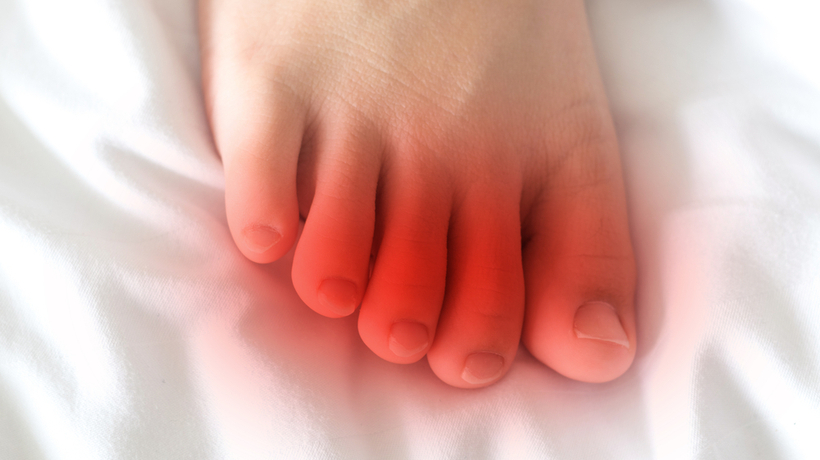Some people pay almost no mind to their nails aside from what’s necessary for maintenance, but according to the American Academy of Dermatology Association, the nails can reveal a great deal about a person’s health.
If you’ve noticed any changes to your nails recently, like in color, texture, or shape, its cause might be transient and harmless. There is, however, a possibility that these changes are your body’s way of letting you know that something is going on that needs medical attention.
If you notice any of the following symptoms, make an appointment with a dermatologist for evaluation.
Dark streak
Medical name: Acral lentiginous melanoma
If your fingernail or toenail has a dark streak, or stripe, that is either new or changing in appearance, a visit to your dermatologist is definitely in order. This could potentially be a sign of melanoma, the most deadly type of skin cancer. Not every dark streak is cancer, but it is important to be evaluated immediately for the best chance of successful treatment if cancer is the cause.
Nail lifting up
If you notice white discoloration covering part of your nail, it could be that your nail is becoming detached. Causes can include a fungal infection, psoriasis, injury from an aggressive manicure, and injury as the result of cleaning under your nails with a sharp object. Other, more serious possible causes include a serious yeast infection or thyroid disease.
Redness and swelling around a nail
Medical name: Paronychia
Redness and swelling around a nail can indicate an infection. If diagnosed early, the infection could be treated with soaks and antibiotics. However, if treatment is delayed, an open sore could form, and more-extensive treatment could be necessary.
Greenish black color
Medical name: Paronychia
If bacteria is the cause of your nail infection, the nail can turn a blackish green. Though rare, if left untreated, this infection might spread to other parts of the hand or foot and become serious.
Yellow nails
Medical name: Yellow nail syndrome
If your nails look golden or yellow, the cause could be as simple as weaning red nail polish without a base. But if your nails are also thickening and growing out of control, it could be a sign of something more serious, like lung disease, rheumatoid arthritis, or a serious nail infection.
Deep grooves (or gaps)
Medical name: Beau lines
Often, lines that run the length of your nail are nothing to worry about. But if you notice a deep groove that runs across the width of your nail, it means that something has caused your nail’s growth to stop or seriously slow down for a period of time. This could look like a gap where part of the nail is missing. The condition is called onychomadesis; its causes range from fever and injury to chemotherapy treatment or major stress.
Ram’s horn nails
Medical name: Onychogryphosis
Ram’s horn nails occur when the nail thickens and overgrows. The condition could be genetic, or it could be caused by a disease such as psoriasis, ichthyosis, or circulation problems.
Help from a podiatrist or dermatologist is necessary to cut and treat the nails. Proper treatment is necessary to prevent the condition from progressing to the point where it interferes with daily life.
Thin, spoon-shaped nails
Medical name: Koilonychia
If your nails are thin and dipping into the shape of a spoon, you might be lacking iron. An iron deficiency can be caused by issues ranging from lack of proper nutrition to stomach or intestinal problems.
Curved nails
Medical name: Clubbing
You might not notice at first that your nails are beginning to curve downward, but as it continues, fingertips mat swell and the nail might start to feel spongy. The curving can begin so gradually that many people are unaware it’s happening.
Causes of curves nails range from genetics to a disease in the:
- Lungs
- Heart
- Liver
- Stomach or intestine
If you notice this symptom, it’s important to visit a doctor to rule out serious causes and, if necessary, seek proper treatment.
Color change
Diseases elsewhere in the body can cause your nails to change color. Certain color changes can point to certain diseases, as outlined by a table published by the American Academy of Dermatology Association.
Blue nails: Not enough oxygen in your bloodstream
White nails: Liver disease, diabetes
Pale nails: Anemia
Half pink, half white nails: Kidney disease
Yellow nails: Lung disease, nail infection
Dusky red half-moons: Could be lupus, heart disease, alopecia areata, arthritis, dermatomyositis
Blue half-moons: Possible sign of poisoning
The Association emphasizes the importance of making an appointment with a board-certified dermatologist if they notice any unusual symptoms in their nails.
A professional will be able to determine whether the cause is harmless, or if testing and treatment is necessary.
For more information, visit www.aad.org.



